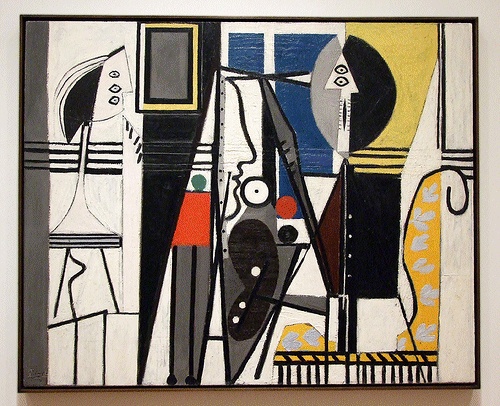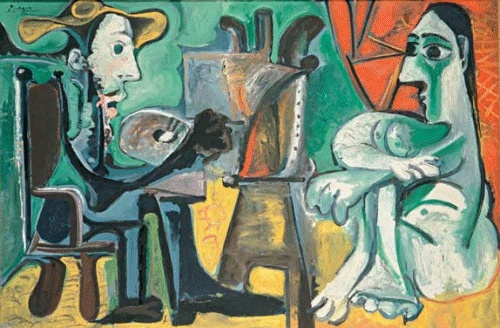
|

'The painter and his model' is a very frequent subject in Picasso's works. Both paintings below were painted
by him in 1928 and 1963 respectively. Look at the paintings and the description of the first. Then work on the assignments at
the bottom of page.
 |
The painter and his model, 1928
A self-portrait of Picasso characterizes the artist seated on the right at his easel1. With palette in one hand and palette
knife2 in the other, he is engaged in working from a model who is posing at the other side of the room. On the canvas before
him is the profile painted from the model. In the center background is a red-topped table with a green apple, above
which hangs a framed mirror. One of the two apples resting on the window sill reappears near the profile-portrait of
the model.
The picture contains one of the rare flashes of Picasso humor, which grows to the proportions of a commentary by the
manner and force with which it is integrated as an idea into the structure of the composition. The artist and his model
are abstracted to an advanced degree while the concept in the canvas on the easel is in terms of realism. By this
reversal in the scheme of reality the extraordinary artist and model are declared ordinary and the natural profile
becomes the astonishing product of the artist's invention.
The impulse from which this concept emerges is visualized as a shaft of light3 projected literally from the artist's
brain. The light converges to a point where it forms a contact with the palette knife, after which it opens up in
hour-glass fashion as crystallization, releasing upon the canvas a visible image - the natural profile. The concentration
of this white light is most intense on the small canvas, where the pigment is built up stratum4 upon stratum, embedding
the black line in a deep rut down which the profile flows like a river. The action of the surrounding white triangles
produces a prismatic reflection of the light, and this encases the whole area of the easel in a rapture5 of visionary
excitement.
A large oblique6 area is thus suddenly and surprisingly interjected in the composition as the center of dynamics.
By a constant recession of front planes and equally forceful advance of rear planes, Picasso achieves a counterbalance
of spatial weights producing two-dimensional equilibrium7. This activity is assisted by the directional drive of the
heavy black lines, through the open construction of which it may be observed.
The various color values are employed in similar action, by which means the widely different gradations of tone and
quantities of saturation are brought into a common level on the surface plane.
Picasso has avoided the deflated vitality of decorative flat pattern by transforming the three dimensions of nature into
plastic elements of a new two-dimensional integration.
430 words
By HARRIET JANIS
Source: Cubism and Abstract Art by Alfred H. Barr, Jr., The Museum of Modern Art, New York 1936, pp. 100/101
|
 |
The painter and his model, 1963
|
Annotations:
1. easel - Staffelei
2. palette knife - Spachtel
3. shaft of light - Lichtstrahl
4. stratum - Schicht
5. rapture - Begeisterung, Rausch
6. oblique - schräg
7. equilibrium - Balance, Gleichgewicht
Assignments:
1. Determine all the terms of the gadgets a painter uses when painting a picture.
2. What is the meaning of 'Picasso humor' as described in above text?
3. What does Picasso achieve by his using shapes and light in this painting?
4. To what tradition of abstract art does Picasso belong with with his painting of 1928?
5. Compare the two paintings emphasising the differences concerning colors, shapes and the degree of abstractness.
|


